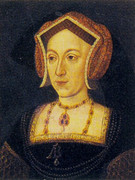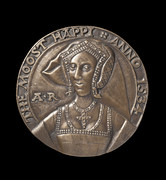-
marie..
User deleted
 CITAZIONEThere is some dispute over the year in which Anne was born – most likely between 1501 and 1507. Anne's father was the courtier and diplomat, Sir Thomas Boleyn and her mother, Elizabeth, was the daughter of the Duke of Norfolk.
CITAZIONEThere is some dispute over the year in which Anne was born – most likely between 1501 and 1507. Anne's father was the courtier and diplomat, Sir Thomas Boleyn and her mother, Elizabeth, was the daughter of the Duke of Norfolk.
Childhood
Anne spent some of her childhood and teenage years in Europe she was a lady-in-waiting to Archduchess Margaret in the Netherlands. In 1514, Anne's father arranged for her to be a lady-in-waiting at the French court to Queen Mary, King Henry VIII's younger sister. She later served Queen Claude of France for almost seven years.
Henry VIII
On her return to England in 1522, Anne was appointed as lady-in-waiting to Henry VIII's wife Catherine of Aragon. Anne's striking looks and sophisticated manners earned her many admirers at court and by 1523 she was betrothed to Lord Henry Percy. However this relationship was cut short by Cardinal Thomas Wolsey.
Before pursuing Anne, Henry VIII had already had an affair with her sister, Mary. Henry showered Anne and her family with titles and gifts. Anne's ambitious father was created Earl of Wiltshire and her brother, Lord George Rochford, was appointed to the Royal Privy Chamber.
Henry VIII had grown tired of his wife, as she had not produced a male heir. He appealed to Pope Clement VII for an annulment to his marriage so that he could marry Anne. The Pope refused to annul the marriage as he was afraid to go against the will of Catherine's nephew Charles V, The Holy Roman Emperor.
Marriage
Although she resisted Henry VIII's advances, by 1533 Anne was pregnant with her first child. Henry was forced into action. In January 1533 Henry VIII and Anne were married in a secret ceremony and Henry broke with the Catholic Church. He passed the Act of Supremacy, declaring that he was the head of the English church. In June 1533 Anne was crowned Queen of England in a lavish ceremony at Westminster Abbey.
Henry and Anne's daughter Elizabeth (the future Queen Elizabeth I) was born in September 1533. Two more pregnancies ended in miscarriage, in the summer of 1534 and in January 1536. When Henry discovered the second baby had been a boy, he became convinced the marriage was cursed. Henry was still desperate for a male heir and he blamed Anne for this misfortune. He took on Anne’s lady-in-waiting Jane Seymour as his mistress and looked for a way to end his marriage.
Downfall
In April 1536, Sir Francis Weston, William Brereton, Mark Smeaton, Sir Henry Norris and Anne's brother Lord Rochford were arrested on suspicion of having had relations with the Queen.
Anne was investigated by a secret commission which included her father, her uncle the Duke of Norfolk and Thomas Cromwell. On 2 May 1536 Anne was arrested on charges of adultery with five men including her own brother, Lord George Rochford. At the trial, presided over by the Duke of Norfolk, Anne was accused of adultery and witchcraft. She was convicted and imprisoned in the Tower of London.
Death
On 19th May Anne was led from her quarters to Tower Green where, spared the axe, she was granted the 'mercy' of beheading by a French swordsman. Anne was the first English queen to be publicly executed. Rather than deny her guilt, she used her final moments to deliver a speech praising King Henry VIII, stating that, "a more merciful prince was there never: and to me he was ever a good, a gentle and sovereign lord."
BBC HistoryCITAZIONEPossible Anne Boleyn portrait found using facial recognition software
She won the heart of King Henry VIII, divided the church and lost her head. But nearly 500 years after Anne Boleyn met her death, only one uncontested portrait of her remains.
Pictures of the beguiling queen – who is played by a steely Claire Foy in the hit BBC historical drama Wolf Hall – were roundly destroyed after her death in 1536. The concerted effort to erase her from history was thorough, leaving only a battered lead disc as a contemporary likeness, the Moost Happi medal in the British Museum in London.
But another portrait from the late 16th century has emerged as a likely painting of the queen. Researchers in California used state-of-the-art face recognition to compare the face on the Moost Happi medal with a number of paintings and found a close match with the privately owned Nidd Hall portrait, held at the Bradford Art Galleries and Museums.
The Nidd Hall artwork shows a woman wearing jewellery long thought to be Boleyn’s. But scholars have been divided on the figure’s identity. Some claim the woman is Boleyn’s successor, Jane Seymour, the third wife of King Henry VIII.
Amit Roy-Chowdhury, head of the video computing group at the University of California in Riverside, turned his expertise in computer face-recognition to renaissance art after he was asked for help by an art historian, Conrad Rudolph, a colleague at the university. “I had no idea about what art history really was,” he said. “My last interaction with art was probably some time in middle school.”
Three years later, Roy-Chowdhury has developed a program that learns to identify faces from their anatomical dimensions, such as the width of their noses, and the distance between their eyes, and more distinctive features, such as whether they have one straight eyebrow and one curved. After training the computer on pictures of known people, it can scan images of unknown characters and churn out probabilities on their identities.
guardianCITAZIONEAnna Bolena ritrova la facciaAnna Bolena ritrova la faccia
Ha conquistato il cuore di re Enrico VIII, diviso la chiesa d’Inghilterra ed è stata decapitata nel 1536 nella Torre di Londra per tradimento e stregoneria. Ma 500 anni dopo la sua morte, Anna Bolena, la più famosa delle mogli del re d’Inghilterra, è anche quella la cui immagine è più avvolta dal mistero. È dubbio che sia lei la donna in quelli che erano considerati due famosi ritratti della regina, conservati alla National Portrait Gallery di Londra. Mentre «il ritratto di Nidd Hall», che si riteneva fosse il ritratto della terza moglie di Enrico VIII, Jane Seymour, potrebbe invece essere quello della Bolena. Lo sostengono dei ricercatori californiani che hanno applicato ai dipinti una sofisticata tecnica di riconoscimento dei volti basata su un algoritmo. Come riferimento gli scienziati hanno usato una miniatura del British Musuem, considerata l’unica immagine autentica della seconda moglie di Enrico VIII, la famosa medaglia «Moost Happi», un disco di piombo di quattro centimetri di diametro. La loro conclusione è che «Anna Bolina», copia della fine del XVI secolo di un dipinto del 1533, e il «ritratto del Castello di Hever» non ritraggono la regina che fu «casus belli» per lo scisma della Chiesa anglicana. Le sue fattezze sono tramandate solo grazie a una serie di ritratti postumi di cui appunto «Nidd Hall» è un esemplare.
cds
Parentesi: il volto su moneta, ricostruito dalla scultrice Lucy Churchill, era questo qui:
src
x

x
Creata da Emily Pooley, questa è la cera di Anna che si trova all'Hever Castle.
Mi mette quasi soggezione! E in effetti pare molto sensuale.
Edited by ‚dafne - 16/2/2015, 19:24.
Anna Bolena (Anne Boleyn) |




